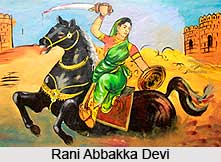 History of Ullal, an ancient town in the south Indian state Karnataka, dates back to the 15th century when it was ruled by the Portuguese. In the middle of 16th century, the place became the capital of the Tulu Kingdom Ullal and was ruled by a Jain Queen named Rani Abbakka Devi. The queen can also be proclaimed as the first promoter of women"s liberation and the people of Ullal took pride in her reign. Rani Abbakka Devi was a Jain princess of 16th century who took over the throne on the death of her sister. She got married to the Bangar King of Mangalore, however their marriage was unsuccessful and in a few years she returned to her kingdom Ullal. The disagreement between the couple about the payments of subsidy demanded by the Portuguese was the main reason for their separation. The king continued to be submissive to the Portuguese while the queen was openly rebellious. This led to the steady worsening of the relation between the royal couple which finally ended up in divorce. The queen also returned all her jewels to her ex-husband after their divorce.
History of Ullal, an ancient town in the south Indian state Karnataka, dates back to the 15th century when it was ruled by the Portuguese. In the middle of 16th century, the place became the capital of the Tulu Kingdom Ullal and was ruled by a Jain Queen named Rani Abbakka Devi. The queen can also be proclaimed as the first promoter of women"s liberation and the people of Ullal took pride in her reign. Rani Abbakka Devi was a Jain princess of 16th century who took over the throne on the death of her sister. She got married to the Bangar King of Mangalore, however their marriage was unsuccessful and in a few years she returned to her kingdom Ullal. The disagreement between the couple about the payments of subsidy demanded by the Portuguese was the main reason for their separation. The king continued to be submissive to the Portuguese while the queen was openly rebellious. This led to the steady worsening of the relation between the royal couple which finally ended up in divorce. The queen also returned all her jewels to her ex-husband after their divorce.
War of Rani Abbakka Devi and Bangar King
While Rani Abbakka Devi was on an expedition on the Nethravathi, a war was declared against her by the Bangar King and the queen was captured. She was imprisoned and was presented before her ex-husband. The queen acted cleverly on this occasion and delighted the Raja of Bangar with all her womanly charms which provoked him to set her free and return all her lands to her. The king also attempted to refurbish their eternal friendship but when she reached the boundaries of her own kingdom she declared war against the king. For defeating the Raja of Bangar, she sought the help of the powerful Raja of Bednore. On the other hand, the Bangar Raja had formed an alliance with the Portuguese for subjugating his wife. In the war the Bangar Fort was demolished and the Bangar-Portuguese alliance was defeated. However the queen had to give away the fertile tract of land at Berdatte to the Bednore King for his support.
War of Rani Abbakka Devi and the Portuguese
After defeating her husband successfully, the queen then turned her focus to the Portuguese against whom she had always been rebellious. A number of expeditions were sent against the queen by the Portuguese but she successfully repulsed them with the help of the Zamorin of Calicut. In 1566 another expedition was sent under Jaoa Piexoto which proved to be disastrous for the Portuguese. During that expedition she surrounded the Portuguese army at night with only her Moghveer and Beary warriors. Using crafty steps she defeated the Portuguese.
Decline of Rani Abbakka Devi"s Reign
The defeat of the Portuguese, that too at the hands of a woman enraged them further and they once again sent a veritable armada under the commandership of the Portuguese Governor. Although initially the queen succeeded, she got betrayed later by some of her own people who traded their loyalty for a casket of silver. The army of Rani Abbakka Devi was outnumbered and in a bloody massacre, the queen escaped to the hills. However another version states that she killed herself which she considered better than surrendering to her enemy.



















